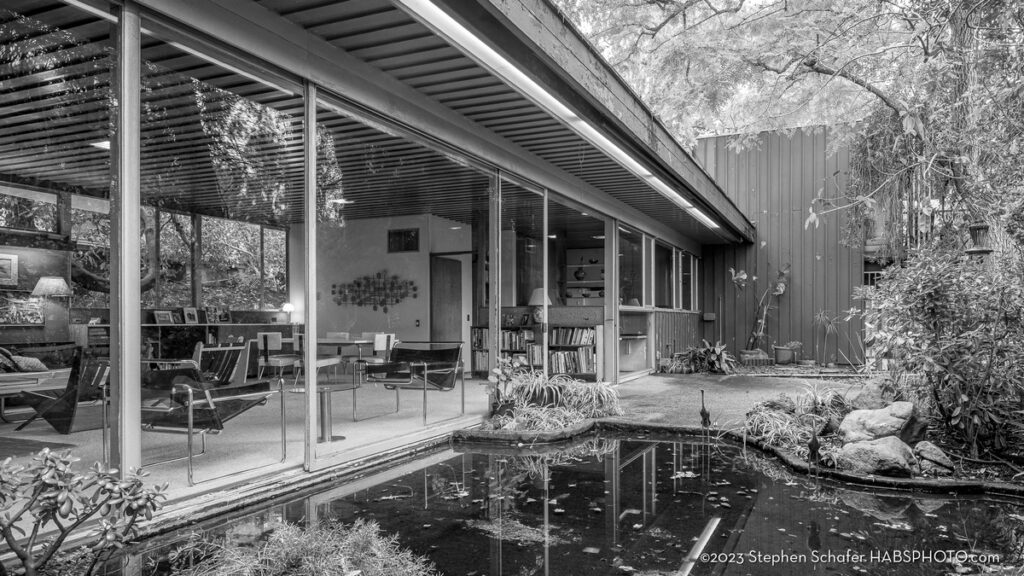Stephen Schafer, renowned HABS photographer, has conducted workshops in documentation for preservation professionals at Reunion House (Richard J. Neutra, 1950). As a result, “Schafe” shot HABS photos of the property. The Institute recently engaged him about his work:
For more information, go to https://www.habsphoto.com/Artist.asp?ArtistID=14047&Akey=E4VXE478&ajx=1
1. What is HABS?
Besides a nickname for the Montreal Canadiens hockey team, or an acronym for high altitude balloons… HABS stands for the Historic American Buildings Survey, which is a National Park Service (NPS) documentation program established in 1933 during the Great Depression, to record America’s vanishing historic architecture and store the archival records at the Library of Congress (LoC). While HABS was intended to be a one-year make-work program, no one could have guessed that it would endure 90 years to become America’s oldest preservation program.
2. What is HABS photography?
When a building is recorded for HABS, the documentation requires three components: 1. measured drawings, 2. historic reports, and 3. photography. All the components must be accurate, durable, archival and available to the public. The photographs must be made on 4”x5” or 5”x7” large format film with specialized lenses that allow for optical perspective correction. Most contemporary color pictures are digitally manipulated in Photoshop and meant to make buildings look impressive and grand. HABS photographs are meant to document historic data, show changes over time and be truthful records of the subject (and HABS photos cannot be retouched or altered in any way).
3. When is it used?
HABS documentation is done to record significant historic buildings to ensure there is a document of the site before changes occur to the building, the surrounding context or the use, or to ensure that the building is well documented before alterations, rehabilitation or for insurance purposes. Many times, however, HABS photographs are made as mitigations before historic buildings are demolished for another project.
4. Why is it B&W and not color?
Black and white film is still required because of its detail and longevity. If properly exposed, the detailed data in large format negatives allows extreme enlargement of tiny details. If properly developed and carefully stored, black and white negatives will last over 500 years because the image is made up of highly stable metallic silver crystals. Color film is made with colored dyes that do not have the stability or life expectancy of silver black and white film.
5. Are you limited in the number of photographs you can submit?
There is no official limit to the photographs of a building that can be taken. However, there is always a limit to a photographer’s time, and a client’s budget. Duplicative photographs do not expand the understanding of a building. Photographing every door knob or every tile in the Reunion House’s kitchen isn’t as important as getting clear photographs that put the tiles clearly in context and show the changes (or lack of changes) in the kitchen.
6. How can the public access them?
Just search the Historic American Buildings Survey collection at the Library of Congress website. Official and donated HABS records are transmitted to the LoC by architects, historians and photographers, and after a time the drawings, reports and negatives are scanned and made available on the LoC website as high-resolution downloads, which are all copyright free for everyone to use.
7. Why do you need a special photographer?
It’s not that I’m special. Nor are any of my HABS photographer peers. But because we are still doing photographs “the old-fashioned way,” HABS photographers have become a rare bunch of documentary photographers who are still using large format cameras and black and white film in an age when most of the architectural photography profession has adopted digital technology. New digital capture guidelines will be coming to HABS in the future though, so many more photographers will be able to create HABS records when Born-Digital HABS photography guidelines are released.
8. How are they stored at the Library of Congress?
Very carefully. Currently, the archivally developed negatives and drawings are transmitted to the HABS department at the National Park Service. After being digitally scanned for web distribution, and made keyword searchable, they are sent for long term storage in a temperature- and humidity-controlled facility at Fort Meade in Maryland. But anyone who wants to access the records in person can call them up through the LoC Prints and Photographs Department.
9. What kinds of projects have you photographed over the years?
I have documented hundreds of universities, hospitals, shops, ships, discos, factories, hot dog stands, hotels, churches, bridges, tunnels and city halls. From early California adobes to mid-century modern skyscrapers, from the beautiful Ahwahnee Hotel in Yosemite National Park to Death Row at San Quentin Prison. From Neutra’s Kaufman Desert House, to the Roberts House, to the Kuhn House to the Reunion House.
10. Are you also a commercial photographer?
I don’t only do HABS photography, but I like to say that my favorite clients are dead architects. I also have many live architect clients that want me to make their new buildings look impressive and grand in digital color. (But most architects die eventually, so it all works out.)
